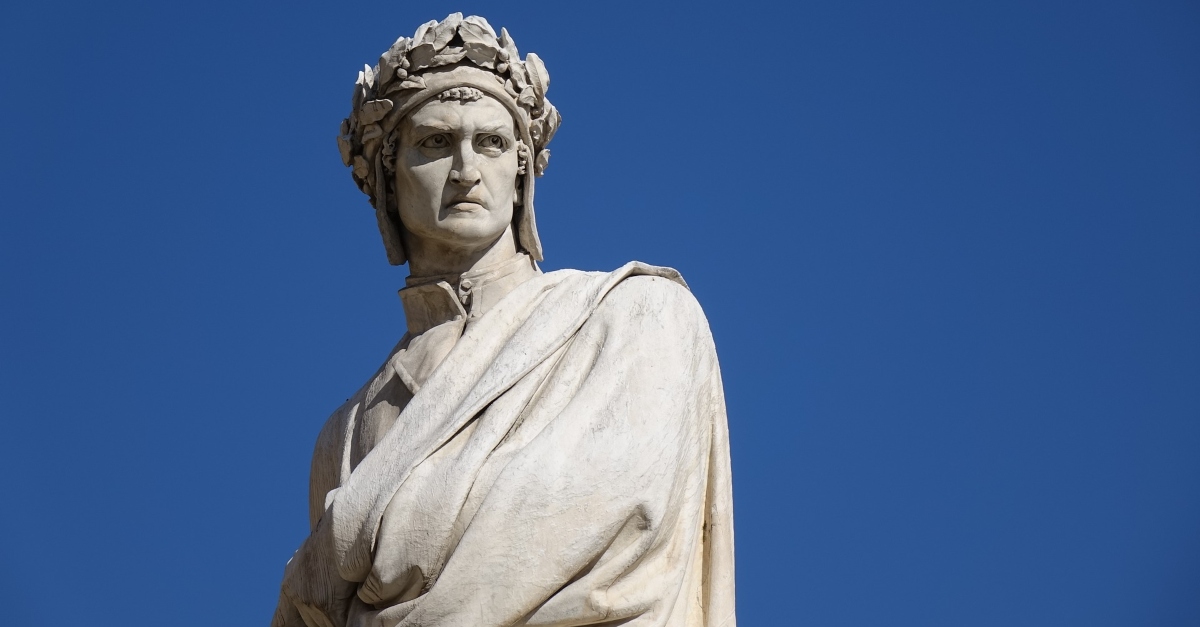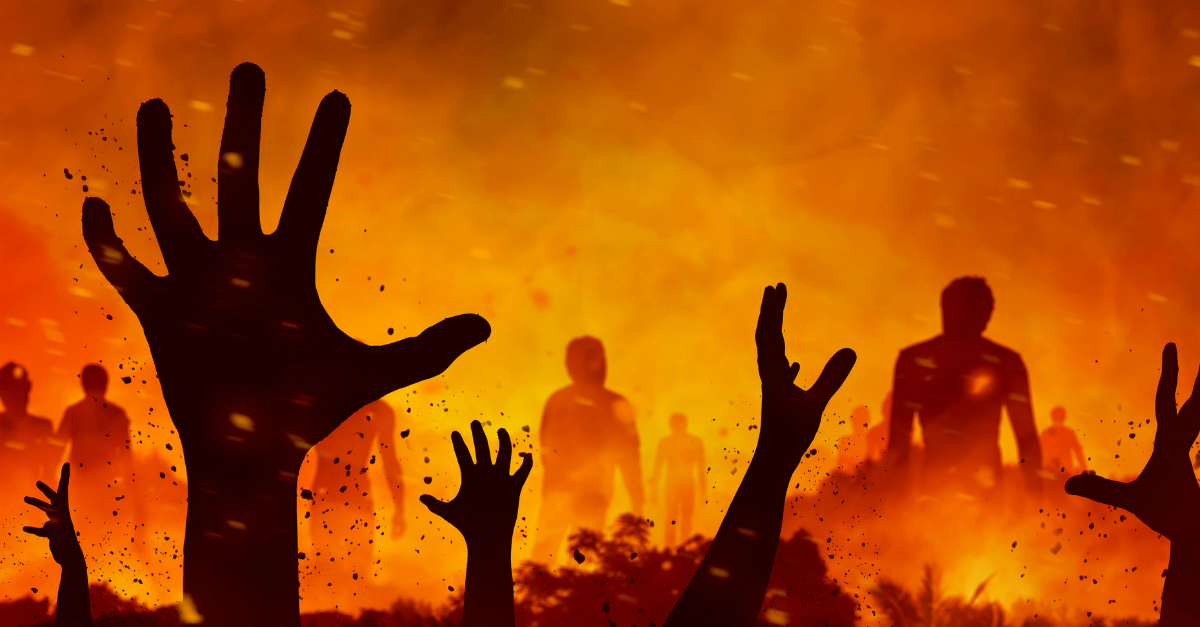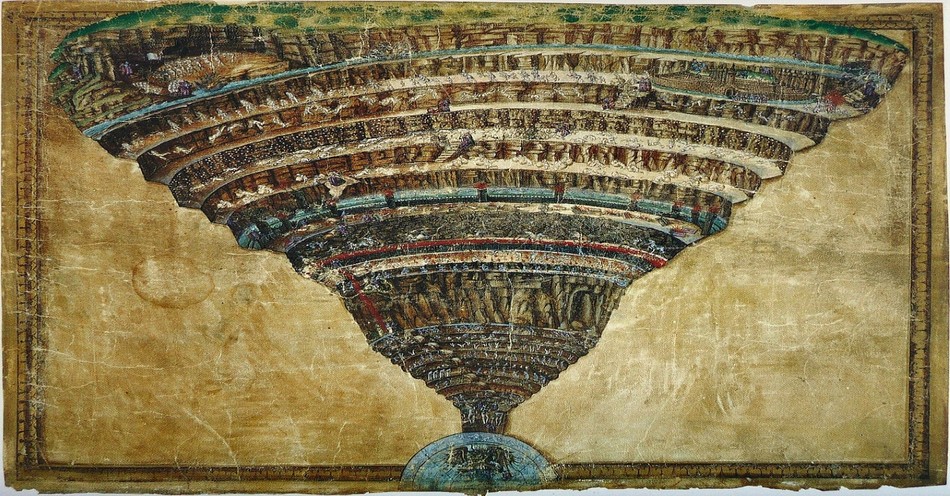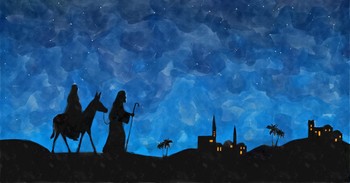You may have heard the idea that are many levels of Hell, depending on what sins people commit and the appropriate punishments. While Revelation 19:20 mentions certain people burning in a lake of fire, which may mean there are special punishments in Hell, the Bible doesn’t describe any levels of Hell. The idea comes from a later work that has hugely impacted how Western Christianity sees Hell, providing many of the standard images we know today.

Photo Credit: Pixabay/Rhodan59
Where Do the Levels of Hell Come From?
Dante Alighieri (1265-1321) was a medieval Italian poet who wrote several classic works. The epic poem Commedia (dubbed Divina Commedia a generation later, hence the Divine Comedy) is his best-known work. Written when epics were classified as comedies (happy endings) or tragedies (sad endings), the Divine Comedy describes a pilgrim led by three spiritual guides through three spiritual realms:
- In Inferno, the poet Virgil meets the pilgrim in a forest, then guides him through Hell.
- In Purgatorio, Virgil guides him through Purgatory, with a woman named Beatrice taking over for the last section.
- In Paradiso, Beatrice guides him through Heaven, with Saint Bernard of Clairvaux taking over the last part of the trip.
While each of these three books is classic, Inferno has become the best-known.
Dante lived in a pre-Protestant Reformation period where Purgatory was a common Christian belief. However, the Divine Comedy isn’t his attempt to explain what Hell, Heaven, and Purgatory truly look like. Dante borrows plenty of images and characters from Greco-Roman mythology for his story. His greater point is to use the story of a journey from Hell to Heaven as an allegory for the soul’s trip to God (from darkness to light). Other themes (what humanity looks like without grace, references to Dante’s political career) appear throughout the Divine Comedy.
How Many Levels of Hell Are There in Dante’s Inferno?
In Dante’s Inferno, Hell has nine levels, each smaller than the other. The levels contain people with specific sins, which become more serious the further Dante goes into Hell. Within each level are subdivisions for different crimes and punishments. The nine levels are as follows:
1. Limbo is reserved for virtuous non-Christians and Christians who weren’t baptized. Dante sees such notable inhabitants as Socrates, Homer, and Ovid. Virgil recalls when Jesus came down into Hell and rescued Biblical patriarchs living in Hell (the Harrowing of Hell).
2. Lust is for people who committed fornication. Dante meets such inhabitants as Helen of Troy, Paris, Tristan, and Francesca da Rimini (killed by a husband who found her having an affair with his brother). As punishment, never-ending storm winds tosses the residents back and forth.
3. Gluttony is for people who indulged in too much food. They live in a swamp with a never-ending frozen rainstorm. Dante doesn’t meet famous people here, although he meets a fellow Florentine named Ciacco, and they discuss what will happen to their city (Dante was exiled from Florence for his politics).
4. Greed is for people who coveted possessions, including misers and people who spent money frivolously. The inhabitants perpetually fight each other in a high tower. Dante doesn’t talk to its inhabitants, except for its gate guardian, the Greco-Roman god Plutus (patron god of wealth, not to be confused with Pluto).
5. Wrath is for people who committed anger, most of them perpetually fighting each other in the marshes of the river Styx. Dante sees his political enemy Filippo Argenti, and they argue.
6. Heresy is for people who followed anti-Christian philosophies or views, kept in tombs surrounded by flames. Dante doesn’t see many of the heretics, although he does speak to one of his political rivals, Farinata degli Uberti. Like other heretics in the burning tombs, Farinata followed the teachings of Greek philosopher Epicurus.
7. Violence is for people who committed violence of many kinds, from warmongers to tyrants to people who killed themselves. They are punished in various ways, including being boiled in the River Phlegethon, turned into trees in the Wood of Suicides, and burning on a vast plain. Dante sees Alexander the Great and Attila the Hunt, among others.
8. Fraud is for people who lived on deception, including seduction, con games, selling church offices for money, fortune-telling, thievery, and living as hypocrites. They are punished in various ways, many wallowing in waste pits or left upside-down in pits with their feet burning. Dante sees many famous figures, including soothsayer Tiresias, high priest Caiaphas, and Pope Nicholas III.
9. Treachery is for people who betrayed people close to them. This level is filled with ice, and many offenders are frozen solid. In the very center, Satan himself lives alone on a frozen lake. Dante notices Satan has three heads, each one chewing someone (Judas Iscariot and Julias Caesar’s two betrayers, Brutus and Cassius). Dante climbs down Satan’s giant back to reach Hell’s exit.

Photo Credit: ©GettyImages/FOTOKITA
What Does the Bible Say about Hell?
Unlike some religions, Christianity doesn’t have a holy text that gives a detailed journey or cosmology of all the supernatural realms. There is no Gospel where Jesus tells a story about entering Hell while his body was in the tomb. There is no Old Testament account where a prophet has a near-death experience and enters Hell or heaven.
The Bible does reference three locations that are translated as Hell in English editions of the Bible:
- Sheol is the Old Testament term for where everyone goes after death, sinners and righteous alike.
- Hades is the New Testament’s Greek term for Sheol, sometimes including Greco-Roman expressions like “the gates of Hades.”
- Gehenna is Jesus’ term for where people receive judgment after death. Gehenna was the name for a geographic location, also mentioned in the Old Testament. In Jesus’ time, Gehenna had become a rubbish dump filled with smoke and rats.
Since Jesus uses “Gehenna” or “Hades” to describe a place that didn’t exist before in Jewish thought (a place where some people are punished after death), Christian teachings developed to describe two distinct locations where people go after death. Heaven is where those who have accepted Christ as their savior will go after death. Details about heaven come from Revelation, Jesus’ words to the thief on the cross “today you will be with me in Paradise,” and so on.
Hell is where everyone else goes. The details that Jesus and New Testament writers give about Gehenna and Hades create the popular image of Hell.
- Hell is a dark (presumably subterranean) space
- Hell is where there is “weeping and gnashing of teeth” (Matthew 13:42)
- Hell involves fire, at least for some (Satan burning in a lake of fire)
Different Christian traditions have debated whether the souls in Hell perish eternally (eternal punishment) or eventually get used up and destroyed (annihilationism). Eternal torture is the more popular view. However, advocates of annihilationism argue there is Biblical evidence for it, that eternal torture only became more popular because Augustine preferred that view. Universalism is a minor (generally seen as heretical) view that all souls will eventually be reconciled to God.
Purgatory is a third location for Christians enduring punishment and refinement for unconfessed sins. This idea appeared in various forms during Christian history but reached its defined form in medieval Christianity. Roman Catholicism sees Purgatory as a required doctrine, and some Christians in other liturgical traditions believe it too even it’s not required by their denominations.
What Books Are Inspired by the Divine Comedy?
While the Divine Comedy doesn’t tell us what Hell looks like, and we must remember it is simply fiction trying to convey religious ideas, it is a very interesting work. It’s well worth reading for its religious themes and meditations on concepts like justice, redemption, and devotion. The Divine Comedy has been translated many times, including by noted Christian scholars like Dorothy L. Sayers. Dante also influenced Sayers’ friends Charles Williams (who wrote The Figure of Beatrice) and C.S. Lewis (who referenced the Divine Comedy in several novels).
It can also be interesting to look at some of the works the Divine Comedy has influenced. There have also been countless movies, comic books, stage plays, and musical pieces referencing or commenting on it. Poets like T.S. Eliot (“The Love Song of J. Alfred Prufrock”) and Henry Wadsworth Longfellow (“Mezzo Cammin”) wrote poems either quoting the Divine Comedy or using its rhyme scheme. Others, such as Lesya Ukrainka (“The Forgotten Shadow”), reinterpreted it for other purposes. Novelists, ranging from 20th-century thinkers like Aleksandr Solzhenitsyn (In The First Circle) to contemporary authors like Shawn Smucker (These Nameless Things), have referenced or reimagined the Divine Comedy in their works.
Photo Credit: Public Domain illustration by Sandro Botticelli, via Wikimedia Commons

This article is part of our Bible resource for understanding the significance and meaning of biblical phrases and ideas. Here are our most popular Bible articles to grow in your knowledge of God's Word:
Promises of God in the Bible
Is "This Too Shall Pass" in the Bible?
What Was the Ark of the Covenant?
Top 10 Bible Stories for Kids
“Iron Sharpens Iron” in Proverbs 27:17
"Fearfully and Wonderfully Made" in Psalm 139
“Be Still and Know That I am God” in Psalm 46:10
"No Weapon Formed Against Me Shall Prosper" - Isaiah 54:17




